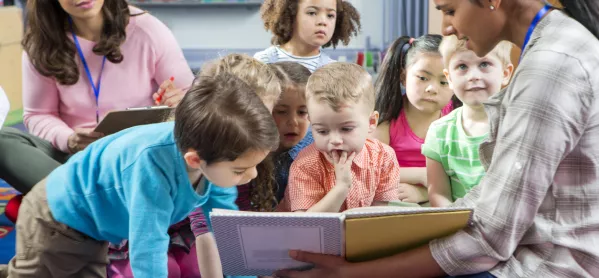I’ve just finished reading my youngest a bedtime story. “Oh look,” I said. “Did you see these two words to describe her dress are adjectives? You’ve been learning about adjectives in school, haven’t you?”
He gave me a pained look.
“Mummy, I know they’re adjectives, but I don’t want to talk about them. Can you just read the story, please?”
He had a point. Stories aren’t written to be dissected as they go. There’s nothing more annoying than an interfering adult trying to turn them into learning time, and I humbly apologise to the wonderful Shirley Hughes for desecrating Alfie in this manner.
Simply reading
Obviously, in school there are times when zooming in on the written word is both right and just. But it’s also important simply to read children a story in a way that makes no demands on the audience other than that they listen and enjoy it.
I know you can’t measure the impact on your spreadsheet, and there’s no written evidence, but you’re playing the long game here. In years to come, they won’t remember answering questions about the simile on page 27. They won’t remember highlighting all the adverbs and adjectives in chapter three.
But they might well remember the day the crayons quit, the time Bertie was reunited with his Butterfly Lion, and the terrifying moment when Stanley Yelnats and Zero came face to face with those lizards (the shudder went round our class like a Mexican wave).
Only two days to go
It’s not just the children who benefit. Story time is one of my favourite parts of the job.
When I taught cover in Year 1, I introduced them to Judith Kerr’s feline heroine Mog, who I drip fed at the rate of a book a week. They were instantly hooked. My arrival was greeted with cries of “Have you got a Mog book for us?” and one little girl accosted me in the playground to shout, “Only two days to go till the next Mog story!”
I think most primary teachers have “story time” writ large on their weekly timetable. But how often does it actually happen?
Fitting all that’s required into a school day is a bit like trying to roll a king-sized duvet into a pillow case, and story time is often the first thing to go. For years, my firm intention has always been to devote the last 15 minutes of the day to it, only to have it swept away by an overrunning science experiment, letters that needed handing out, or any of the other 101 events that fall upon you at the end of the day.
In my time, I’ve done unforgivable things with class books: summarising chapters so we could get through them, reading while half the class were out of the room, and leaving a whole class hanging without an ending when we ran out of time in July.
Hardwired need for stories
But, actually, it’s hard to think of a better use for time in the classroom. I know people in education can get a bit preachy about the sanctity of reading, as if books are some mystical religion and they’re the high priests. But the truth is that the need for stories is hardwired into us. For many children, school might be the only place where they are ever read to.
Beneath all the reading razzmatazz of decorated book corners, reading events, posters and library visits, sits the daily story time.
It’s low-cost and low-effort. It needs no technology, no planning or differentiation. In the right circumstances, it can provide more pastoral care than hours of circle time. It will also make you happy, so don’t skip it.
Read to your class. Every day. End of story.
Jo Brighouse is a pseudonym for a primary teacher in the West Midlands. She tweets @jo_brighouse





